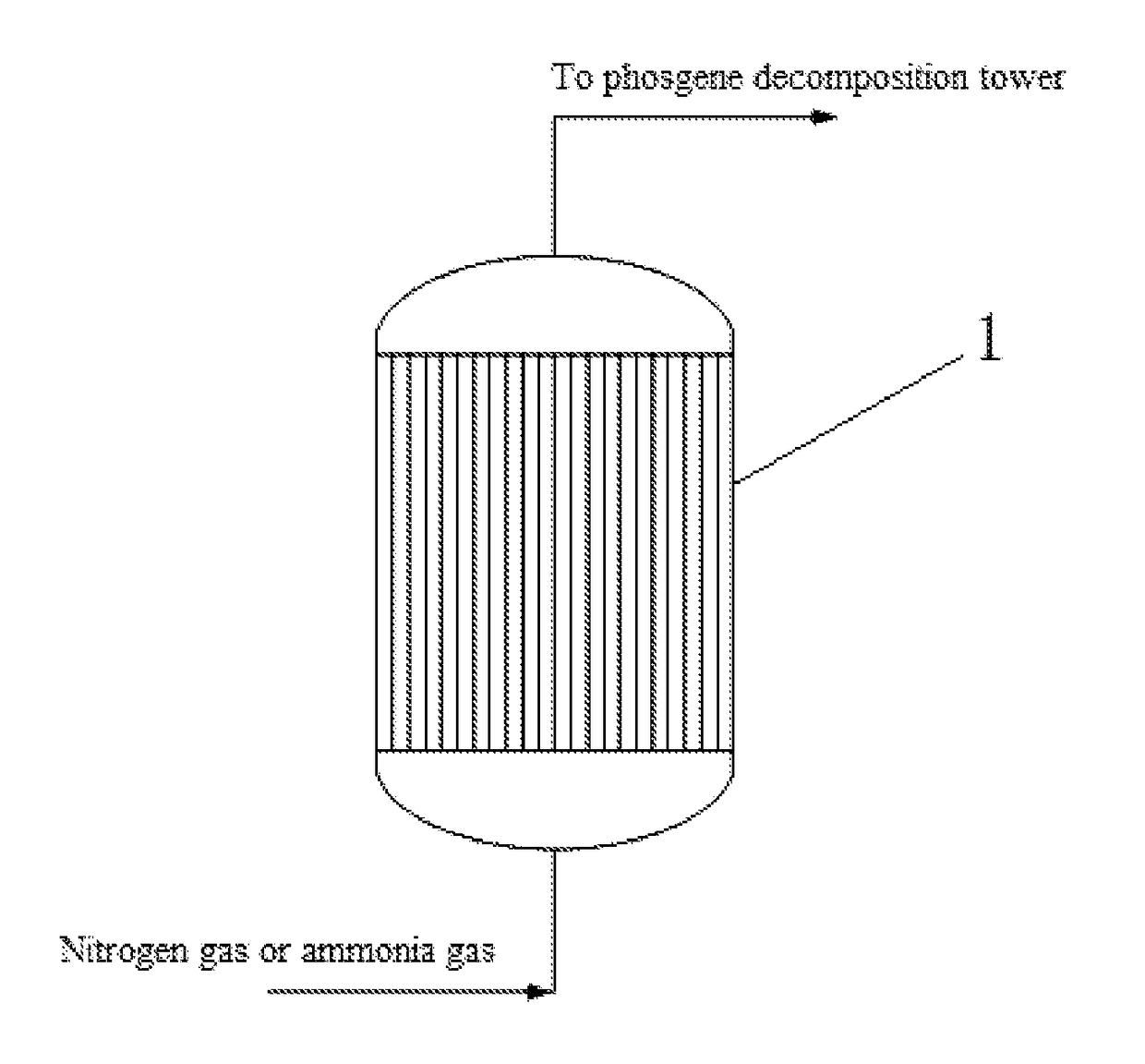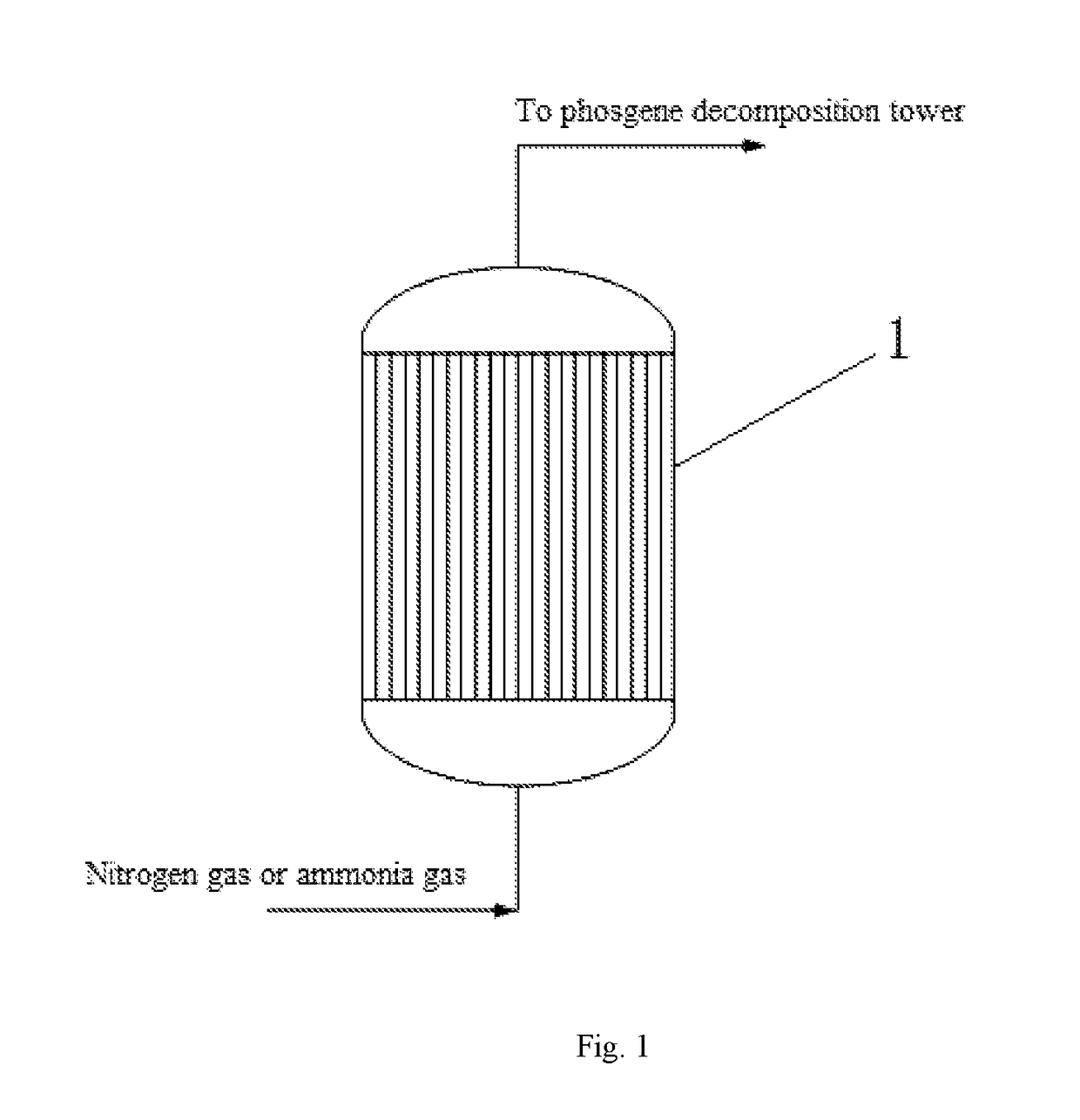Method for replacement of phosgene synthesis column catalyst
- Summary
- Abstract
- Description
- Claims
- Application Information
AI Technical Summary
Benefits of technology
Problems solved by technology
Method used
Image
Examples
example 1
[0040]After feeding to the phosgene synthesizing tower was stopped, 100 Nm3 / h of nitrogen gas was introduced from the bottom of the synthesizing tower, wherein the temperature of the nitrogen gas was 100° C., the moisture content in the nitrogen gas was 100 ppm, and the pressure of the nitrogen gas was 0.15 MPa. The nitrogen gas was continuously introduced for 2 days, and the phosgene concentration at the outlet of the phosgene synthesizing tower was measured as 0.45% (v / v) after purging. Ammonia gas was then introduced for purging. The ammonia gas was first introduced to build up the pressure, the phosgene synthesizing tower was built up pressure to 1 MPa and maintained at this pressure for 2 h, and then the outlet of the phosgene synthesizing tower was opened, and the process of building up pressure was repeated for 8 times as such. And then ammonia gas was continuously introduced, the flow of the ammonia gas was 80 Nm3 / h, the temperature of the ammonia gas was 40° C., and the moi...
example 2
[0041]After feeding to the phosgene synthesizing tower was stopped, 200 Nm3 / h of nitrogen gas was introduced from the bottom of the synthesizing tower, wherein the temperature of the nitrogen gas was 120° C., the moisture content in the nitrogen gas was 300 ppm, and the pressure of the nitrogen gas was 0.2 MPa. The nitrogen gas was continuously introduced for 3 days, and the phosgene concentration at the outlet of the phosgene synthesizing tower was measured as 0.3% (v / v) after purging. Ammonia gas was first introduced to build up the pressure, the phosgene synthesizing tower was built up pressure to 2 MPa and maintained at this pressure for 4 h, and then the outlet of the phosgene synthesizing tower was opened, and the process of building up pressure was repeated for 4 times as such. And then ammonia gas was continuously introduced, the flow of ammonia gas was 100 Nm3 / h, and the temperature of the ammonia gas was 60° C. Purging with the ammonia gas was continued for 3 days, and the...
example 3
[0042]After feeding to the phosgene synthesizing tower was stopped, 400 Nm3 / h of nitrogen gas was introduced from the bottom of the synthesizing tower, wherein the temperature of the nitrogen gas was 150° C., the moisture content in the nitrogen gas was 200 ppm, and the pressure of the nitrogen gas was 0.25 MPa. The nitrogen gas was continuously introduced for 6 days, and the phosgene concentration at the outlet of the phosgene synthesizing tower was measured as 0.1% (v / v) after purging. And then Ammonia gas was introduced for purging, the ammonia gas was first introduced to build up the pressure, the phosgene synthesizing tower was built up pressure to 3 MPa and maintained at this pressure for 5 h, and then the outlet of the phosgene synthesizing tower was opened, and the process of building up pressure was repeated for 5 times as such. And then ammonia gas was continuously introduced for purging, the flow of the ammonia gas is 150 Nm3 / h, and the temperature of the ammonia gas was ...
PUM
| Property | Measurement | Unit |
|---|---|---|
| Temperature | aaaaa | aaaaa |
| Temperature | aaaaa | aaaaa |
| Temperature | aaaaa | aaaaa |
Abstract
Description
Claims
Application Information
 Login to View More
Login to View More - R&D
- Intellectual Property
- Life Sciences
- Materials
- Tech Scout
- Unparalleled Data Quality
- Higher Quality Content
- 60% Fewer Hallucinations
Browse by: Latest US Patents, China's latest patents, Technical Efficacy Thesaurus, Application Domain, Technology Topic, Popular Technical Reports.
© 2025 PatSnap. All rights reserved.Legal|Privacy policy|Modern Slavery Act Transparency Statement|Sitemap|About US| Contact US: help@patsnap.com


